|

|
|
| |
|
China Oil Painting Direct
|
|
100% hand painted, 100%
cotton canvas,
100% money back if not satisfaction.
|
|
|
|
ART WORKS
INDEX
A B C D E F G H I J K L M N O P Q R S T U V W X Y Z
|
|
ARTISTS
INDEX
A B C D E F G H I J K L M N O P Q R S T U V W X Y Z
|
|
|
|
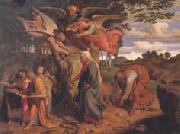 |
Josef fuhrich 
|
|
1800-1876
|
|
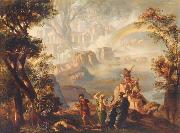 |
Josef Hoffmann 
|
|
painted Outside the Hall of the Gibichungs in 1876
|
|
 |
Josef Schmitz 
|
|
Johann Josef Schmitz (1784-)Aliases: Johan Joseph SchmitzProfessions: Landscape painter.
|
|
 |
Josef Wilhelm Wallander 
|
|
1821-1888
|
|
 |
Josefa of Ayala 
|
|
1630-1684,Portuguese painter and engraver. She was the daughter of the Portuguese painter Baltazar Gomes Figueira (1597-1674) and a Spanish lady, Doea Catarina de Ayala y Cabrera. After the restoration of the Portuguese monarchy in 1640 the family moved to Coimbra. Here Josefa began her apprenticeship under her father, a painter of landscapes, still-lifes and religious works, who in 1644 painted the retable of Nossa Senhora da Graea, Coimbra, in the naturalist-tenebrist style he had learnt in Seville in the circles of Juan del Castillo,
|
|
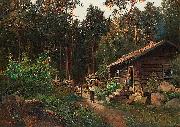 |
Josefina Holmlund 
|
|
(1827 -1905 ) - Painter
|
|
 |
Josehp Bruggemann 
|
|
painted Vista do Desterro in 1867
|
|
 |
Josep Morell Macias 
|
|
Spain (1899- 1949 )
painted Arreglant-se per anar a ballar in 1882
|
|
 |
Joseph A Kleitsch 
|
|
1885-1931
Joseph Kleitsch (1885-1931) was an American painter who holds a high place in the early California School of Impressionism. Born in Banad, Hungary on June 6th, 1885, young Joseph Kleitsch was drawn to paint at the early age of seven, he later pursued his professional art training at Budapest, Munich and Paris. Influenced by his visits to the famous museums of Europe, Kleitsch continued with his love of portrait and figuritive painting after relocating to California. There he rose to the challenge of capturing his new environment's brilliant light and diverse landscape. Living in Los Angeles for a while, Kleitsch fell in love with the rustic artist village of Laguna Beach. There he painted the town's eucalyptus lined streets, the crashing waves of the Pacific coastline and the nearby Mission San Juan Capistrano. Arthur Millier of the Los Angeles Times in 1922 was quoted saying of Kleitsch "he was a born colorist; he seemed to play on canvas with the abandon of a gypsy violinist". Joseph Kleitsch died at the age of forty-nine in Santa Ana, California on November 16th, 1931.
|
|
 |
Joseph Albrier 
|
|
(1791 -1863 ) - Painter
|
|
 |
Joseph Allen 
|
|
1780 - 1860
|
|
 |
Joseph Anton Koch 
|
|
1768-1839
Austrian
Joseph Anton Koch Galleries
was an Austrian painter of the German Romantic movement. The Tyrolese painter left academic training in the Karlsschule Stuttgart, a strict military academy, and traveled through France and Switzerland. He arrived in Rome in 1795. Koch was close to the painter Asmus Jacob Carstens and carried on Carstens' 'heroic' art, at first in a literal manner.
After 1800 Koch developed as a landscape painter. In Rome he espoused a new type of 'heroic' landscape, revising the classical compositions of Poussin and Lorrain with a more rugged, mountainous scenery. He left Rome in 1812 and stayed in Vienna until 1815, in protest of the French invasion. During this period he incorporated more non-classical themes in his work. In Vienna he was influenced by Friedrich Schlegel and enthusiasts of old German art. In response, his style became harsher, and this new approach had a wide influence on German landscape painters who visited Rome.
|
|
 |
Joseph Badger 
|
|
(ca.1707-1765) was a portrait artist in Boston, Massachusetts in the 18th-century. He painted some 80 portraits of merchants, businessmen, clergy, and other notables, and their wives and children.
Badger was born in Charlestown, Massachusetts, to tailor Stephen Badger and Mercy Kettell. In 1731 he married Katharine Felch; they moved to Boston around 1733. He was a member of the Brattle Street Church.
He "began his career as a house-painter and glazier, and ... throughout his life continued this work, besides painting signs, hatchments and other heraldic devices, in order to eke out a livelihood when orders for portraits slackened."
|
|
 |
Joseph Barney 
|
|
(1753 - 13 April 1832), was an English artist and engraver. He is usually described as a pupil of Antonio Zucchi and Angelica Kauffmann and as a fruit and flower painter to the Prince Regent. He was born in Wolverhampton.
Two of his large-scale paintings - altar pieces eThe Deposition from the Crosse (1781) and eThe Apparition of Our Lord to St Thomase (1784) have been preserved in Wolverhampton, and can be seen today at St Johnes church and at St Peter & St Paules Roman Catholic church. During Barneyes life-time, his artistic achievements were respected and praised. In 1798, Stebbing Shaw, mentioning eThe Deposition from the Crosse in his eHistory of Staffordshiree called Barney a enative geniuse of Wolverhampton. In the collection of Wolverhampton Art Gallery, there is a pen and ink drawing, eA Blind Musiciane, which gives some additional idea of quality and versatility of Barneyes works.
|
|
 |
Joseph Benoit Suvee 
|
|
1747-1807
French
Joseph Benoit Suvee Gallery
|
|
 |
Joseph Bidauld 
|
|
Carpentras(Vaucluse)1758-Montmorency (Val d'Oise)1846
French painter. He was apprenticed in Lyon for six years with his brother Jean-Pierre-Xavier Bidauld (1745-1813), a landscape and still-life painter. Subsequently, they left Lyon to travel together in Switzerland and Provence. In 1783 he moved to Paris, where he met Joseph Vernet (from whom he received valuable advice), Joseph-Siffred Duplessis and Jean-Honor? Fragonard. In 1785 he went to Rome with the assistance of Cardinal de Bernis and his patron, the dealer and perfumer Dulac. He stayed there for five years, travelling through Tuscany, Umbria and Campania and painting such works as Roman Landscape (1788; Basle, Kstmus.). Bidauld was closely involved with the circle of French Neo-classical painters in Rome in the 1780s. He was friendly with Louis Gauffier, Nicolas-Antoine Taunay and especially with Guillaume Lethiere, who became his brother-in-law and with whom he occasionally collaborated. On his return to Paris in 1790 he travelled extensively in France,
|
|
 |
Joseph Blackburn 
|
|
English-born American Rococo Era Painter, ca.1700-1780
|
|
 |
Joseph Blondel 
|
|
Merry-Joseph Blondel (Paris, July 5, 1781 - Paris, June 12, 1853) was a French neo-classic painter.
After a first training in the Dilh et Guerhard porcelain factory, he later was a painting student of Jean-Baptiste Regnault. He won in 1803 Price of Rome with his painting Enee portant son pere Anchise. He lived in Villa Medicis, in Rome, Italy, from 1809 to 1812, and won a gold award for his painting Mort de Louis XII. He then started a career as an interior decorator (Fontainebleau Castel, Brongniart Palace, Louvre Museum, Senat).
|
|
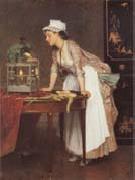 |
Joseph Caraoud 
|
|
French
1821-1905
|
|
 |
Joseph Chelmonski 
|
|
1850-1914
|
|
 |
Joseph clark 
|
|
1934-1926
|
|
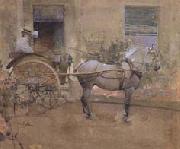 |
Joseph Crawhall 
|
|
1861-1913
English painter, active in Scotland. He was brought up in Newcastle upon Tyne and was encouraged by his father and by Charles Keene, the cartoonist for Punch, studying at King's College School in London under P. H. Delamotte. There he met E. A. Walton, with whom, joined by James Guthrie, he painted at Roseneath, near Glasgow, in 1879. Crawhall also collaborated with Walton and Guthrie on illustration. His association with the Glasgow Boys was consolidated during the early 1880s on further painting trips in the Trossachs, Berwicks, and Crowland, Lincs. A keen huntsman and rider, Crawhall specialized in bird, animal and humorous subjects, and his work, with that of Arthur Melville, exemplifies the achievement of the Glasgow Boys in watercolour. After studying in Paris in 1882 under Aim? Morot (1850-1913), Crawhall exhibited for the first and only time at the Royal Academy, probably showing A Lincolnshire Meadow (1883; Glasgow, A.G. & Mus.). He then virtually abandoned oil painting and the plein-air technique, working instead from memory and using line and watercolour.
|
|
 |
Joseph Decamp 
|
|
1858-1923
Joseph Rodefer DeCamp (November 5, 1858 - February 11, 1923) was an American painter.
Born in Cincinnati, Ohio, he studied with Frank Duveneck in that city. In the second half of the 1870s he went with Duveneck and fellow students to the Royal Academy of Munich, then spent time in Florence, Italy, returning to Boston in 1883.
He became known as a member of the Boston school led by Edmund Charles Tarbell and Emil Otto Grundmann, focusing on figure painting, and in the 1890s adopting the style of Tonalism. He was a founder of the Ten American Painters, a group of American Impressionists, in 1897.
A 1904 fire in his Boston studio destroyed several hundred of his early paintings, including nearly all of his landscapes.
He died in Boca Grande, Florida.
|
|
 |
Joseph Delattre 
|
|
painted Le Port de Rouen in 19th century
|
|
 |
Joseph Denis Odevaere 
|
|
1778-1830,Flemish painter. He attended evening classes at the Bruges Academie in 1794-5 and then went to Paris, where he entered the studio of the Bruges artist Joseph-Benoet Suvee. In 1801 he began training under Jacques-Louis David and in 1804 won the Prix de Rome for his Death of Phocion (Paris, Ecole N. Sup. B.-A.), in which he faithfully adhered to the principles of David's teaching. Before going to Italy he spent a year in Bruges carrying out portrait commissions, including the Marquis de Chauvelin (1805; Bruges, Groeningemus.). During his time in Rome (1805-12) he copied antique and Renaissance works, taking a particular interest in Raphael, who features in his wash drawing the Master of Urbino Introduced by Bramante to Julius II (1807; Bruges, Groeningemus.), a study for a lost painting. Around 1811 he was among the artists chosen to decorate the Palazzo del Quirinale for Napoleon's visit, although he never executed more than a sketch, Tanaquil Predicting the Future Greatness of Servius Tullius (c. 1811-12; Dijon, Mus. Magnin). Odevaere successfully exhibited in Paris in 1812 and then moved to Ghent, showing works at the Salon there two years later. After the union of the Low Countries in 1815 he became official painter to William I. As a result of this post he executed several works illustrating the history of the Dutch royal family, including the Prince of Orange Wounded at Waterloo (1817) and the Battle of Nieuwpoort (1820; both Brussels, Pal. Nation, on dep. Brussels, Pal. Justice). In 1815 he was commissioned to recover works of art taken from the Low Countries by the French. David's arrival in Brussels in 1816 coincided with the beginning of Odevaere's most ambitious composition, the Departure of the Athenians for Salamis (1816-25; Brussels, Mus. A. Anc.), inspired as much by Jean-Auguste-Dominique Ingres as by David, although the latter frequently advised Odevaere on the painting. From 1825 to 1829 he worked on a series of paintings conveying his support of the philhellenic committees created during the Greek War of Independence.
|
|
 |
Joseph Ducreux 
|
|
1735-1802
French
French painter, pastellist and engraver. He lived in Paris from 1760 and from 1762 kept a list of his works. Among the portraits he completed in his early years were those in pastel of the well-known connoisseurs Pierre-Jean Mariette, the Comte de Caylus and Ange-Laurent de la Live de July (all untraced), which apparently were copies after Maurice-Quentin de La Tour. Ducreux has traditionally been seen as de La Tour favourite pupil, while Jean-Baptiste Greuze is supposed to have initiated him into oil painting. From his age, it can be assumed that by the time Ducreux reached Paris he had already acquired a grounding in his art.
|
|
 |
Joseph E.Southall 
|
|
1861-1944
|
|
 |
Joseph Esperlin 
|
|
painted Engagement of Maria Josepha Grafin von Waldburg-Friedberg-Scheer (1731 - 1782) and her cousin, Prince Joseph Wenzel von Furstenberg (1728 - 1783) in 1748
|
|
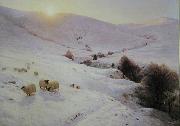 |
Joseph Farqharson 
|
|
painted The Sun Peeped o'er yon Southland Hills
Joseph Farquharson DL (4 May 1846 -15 April 1935) was a Scottish painter, chiefly of landscapes. He is most famous for his snowy winter landscapes, often featuring sheep and often depicting dawn or dusk. He was born in Edinburgh, Scotland and died at Finzean, Aberdeenshire, Scotland.
|
|
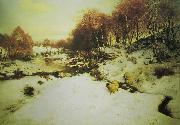 |
Joseph Farquharson 
|
|
Joseph Farquharson DL (4 May 1846 - 15 April 1935) was a Scottish painter, chiefly of landscapes. He is most famous for his snowy winter landscapes, often featuring sheep and often depicting dawn or dusk. He was born in Edinburgh, Scotland and died at Finzean, Aberdeenshire, Scotland.
Joseph Farquharson combined a long and prolific career as a painter with his inherited role as a Scottish laird. He painted in both oils and water colours. His mother, a celebrated beauty, was an Ainslie. His early days were spent in his father's house in Northumberland Street below Queen Street Gardens and later at Eaton Terrace beyond the Dean Bridge, Edinburgh and at Finzean, the family estate in the highlands.[1] His father Francis was a doctor and laird of Finzean. Joseph was educated in Edinburgh and permitted by his father to paint only on Saturdays using his father's paint box. When Joseph reached the age of 12, Francis Farquharson bought his son his first paints and only a year later he exhibited his first painting at the Royal Scottish Academy.
|
|
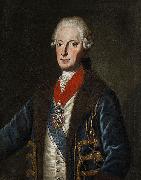 |
Joseph Fischer 
|
|
Joseph Emanuel Fischer von Erlach, also Fischer von Erlach the younger (13 September 1693 in Vienna; 29 June 1742 in Vienna) was an Austrian architect of the baroque, Rococo and baroque classicism
|
|
 |
Joseph Friedrich August Darbes 
|
|
(1747 -1810 ) - Painter
|
|
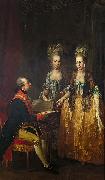 |
Joseph Haunzinger 
|
|
Josef Hauzinger: Marie Antoinette, Erzherzog Maximilian und Ludwig XVI., Ol auf Leinwand, um 1776
|
|
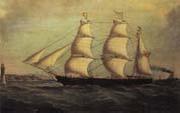 |
Joseph heard 
|
|
British painter, 1799-1859
|
|
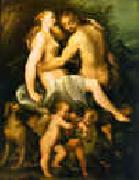 |
Joseph Heintz 
|
|
1564-1609
Swiss
Painter, draughtsman, architect and artistic adviser, son of Daniel Heintz.
He began his training as a painter c. 1579 with Hans Bock I (c. 1550-c. 1623) in Basle. His first surviving drawings (1580) show something akin to Holbein manner in his stained-glass window designs. After completing his apprenticeship he went c. 1584 to Rome, where he studied the works of antiquity, and those of Raphael, Michelangelo, Polidoro da Caravaggio and others. In 1587 he went via Florence to Venice, absorbing the works of Tintoretto, Titian and Veronese. In autumn 1591 the Holy Roman Emperor Rudolf II summoned him as portraitist and court painter to Prague but soon sent him back to Italy, where he drew ancient statues in addition to producing his own work and acting as art agent for the Emperor. In 1592-5 he stayed mainly in Rome, then returned to Prague. In the following years he worked indefatigably as a draughtsman, painter, architect and artistic adviser, moving between Augsburg and Prague.
|
|
 |
Joseph Heintz the Elder 
|
|
the Elder (Basle, 11 June 1564 - near Prague, Bohemia, October 1609) was a Swiss painter, draftsman and architect.
He appears to have been a pupil of Hans Bock, and to have educated himself by diligent practice in copying the works of Hans Holbein the younger. Between 1585 and 1587 he lived in Rome, registering himself a pupil; to Hans von Aachen. He next settled in Bohemia in 1591, and was at once appointed court painter to Rudolf II, but he remained in Prague for two years only, as in 1593 he was commissioned to make some copies from the antique for the emperor, and for that purpose went to Rome, where he spent some years. In 1604 we hear of him in Augsburg, and from the time we know little of his history, until his decease is recorded in a village outside of Prague.
Heintz's paintings included religious images, portraits, and, following the emperor's taste, erotic mythological themes. They were at one time in high demand, but later on suffered an eclipse. Among them are a family portrait in Berne and that of Rudolf II in Vienna. He was constantly investigating subtle questions of light, and almost all of his landscapes show the interest he took in this technical matter. A notable work by him is the Rape of Proserpine, which hangs in the Dresden Gallery, and was engraved by Lukas Kilian; in the same gallery are two other works, Lot and His Daughters and Ecce Homo. Finally there is his portrait of Constance of Austria. He had a son, who bore the same name, and who painted a few religious pictures; several of these works hitherto attributed to the son are now believed to be late productions by the father.
|
|
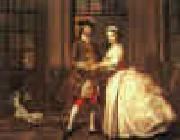 |
Joseph Highmore 
|
|
1692-1780
British
Joseph Highmore Gallery
Joseph Highmore (3 June 1692?C1780), was a British portrait and historical painter.
Born in London in 1692, he displayed early a strong ability, particularly for the fine arts, which was discouraged by his family, who rather saw him as a solicitor. However, all his spare time was dominated by his favourite pursuit and, upon the ending of his clerkship at the age of seventeen, he abandoned law and resolved to trust in future to his talents as a painter alone for his chance of fame and fortune.
His gamble paid off and he continued to improve his reputation and upon the revival of the Order of the Bath in 1725, he was selected to paint the knights in full costume. The years 1732 to 1734 were spent on a tour of the Netherlands and France and on his return to England, he applied himself to perfecting his talent, which continued for the next 50 years of his life, until his death.
Among his best works are biblical "Histories", historical painting being a style which Highmore had picked up on his travels in France. One such biblical painting is Hagar and Ishmael, which was donated to the Foundling Hospital for the purpose of decorating its Court Room (the room where the Court of Governors met). The painting is still part of the Foundling Hospital art collection and can now be seen at the Foundling Museum in London.
As an author, he was best known for the rather longwindedly titled Critical Examination of Reubens' two Paintings in the Banqueting House and Observations on Bodwell's Pamphlet against Christianity.
|
|
 |
Joseph Israels 
|
|
1824-1911
|
|
 |
Joseph Karl Stieler 
|
|
(1 November 1781 - 9 April 1858) was a German painter. Born in Mainz to a family of engravers and die-cutters, Stieler received some artistic training from his father, August Friedrich Stieler (1736 - 1789). Stieler began his career as a painter of miniatures.
His portrait style was most especially shaped during his work in the Parisian atelier of Francois Gerard, a student of Jacques-Louis David. In 1808, he established himself as an independent portraitist in Frankfurt am Main. He traveled through Italy in 1810. In 1816, he traveled to Vienna to paint the portrait of Emperor Francis I of Austria. Between February and April 1820, he worked on his portrait of Beethoven, which is probably the most well-known representation of the composer today.
Stieler worked mainly in the service of the Bavarian court. His painted likenesses in Schloss Nymphenburg, Schönheitengalerie, the so-called Gallery of Beauties, were commissioned by King Ludwig I. Stieler also painted the portraits of Goethe, Amalia of Greece, Friedrich Wilhelm Joseph von Schelling, Johann Ludwig Tieck, and Alexander von Humboldt.
The most distinguishing feature of Stieler's portraits is his utter focus on the sitter. Decorative additions are left out, and there is nothing that distracts the viewer's scrutiny. Stieler accomplished this concentration through deliberate light - dark contrast, which above all highlights the accurately characterized facial features.
He died in Loytown.
|
|
 |
Joseph Kleitsch 
|
|
1881-1931
|
|
 |
joseph lange 
|
|
Joseph Lange (1 April 1751 W??rzburg - 17 September 1831 Vienna) was an actor and amateur painter of the 18th century. Through his marriage to Aloysia Weber, he was the brother-in-law of Wolfgang Amadeus Mozart.
|
|
 |
Joseph Mallord William Truner 
|
|
born: London, England; 23 April 1775 died: London, England; 19 December
1851.
|
|
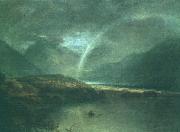 |
Joseph Mallord William Turner 
|
|
English Romantic Painter, 1775-1851
Joseph Mallord William Turner (23 April 1775 ?C 19 December 1851) was an English Romantic landscape painter, watercolourist and printmaker, whose style is said to have laid the foundation for Impressionism. Although Turner was considered a controversial figure in his day, he is now regarded as the artist who elevated landscape painting to an eminence rivalling history painting.
Turner's talent was recognised early in his life. Financial independence allowed Turner to innovate freely; his mature work is characterised by a chromatic palette and broadly applied atmospheric washes of paint. According to David Piper's The Illustrated History of Art, his later pictures were called "fantastic puzzles." However, Turner was still recognised as an artistic genius: the influential English art critic John Ruskin described Turner as the artist who could most "stirringly and truthfully measure the moods of Nature." (Piper 321)
Suitable vehicles for Turner's imagination were to be found in the subjects of shipwrecks, fires (such as the burning of Parliament in 1834, an event which Turner rushed to witness first-hand, and which he transcribed in a series of watercolour sketches), natural catastrophes, and natural phenomena such as sunlight, storm, rain, and fog. He was fascinated by the violent power of the sea, as seen in Dawn after the Wreck (1840) and The Slave Ship (1840).
Turner placed human beings in many of his paintings to indicate his affection for humanity on the one hand (note the frequent scenes of people drinking and merry-making or working in the foreground), but its vulnerability and vulgarity amid the 'sublime' nature of the world on the other hand. 'Sublime' here means awe-inspiring, savage grandeur, a natural world unmastered by man, evidence of the power of God - a theme that artists and poets were exploring in this period. The significance of light was to Turner the emanation of God's spirit and this was why he refined the subject matter of his later paintings by leaving out solid objects and detail, concentrating on the play of light on water, the radiance of skies and fires. Although these late paintings appear to be 'impressionistic' and therefore a forerunner of the French school, Turner was striving for expression of spirituality in the world, rather than responding primarily to optical phenomena.
Rain, Steam and Speed - The Great Western Railway painted (1844).His early works, such as Tintern Abbey (1795), stayed true to the traditions of English landscape. However, in Hannibal Crossing the Alps (1812), an emphasis on the destructive power of nature had already come into play. His distinctive style of painting, in which he used watercolour technique with oil paints, created lightness, fluency, and ephemeral atmospheric effects. (Piper 321)
One popular story about Turner, though it likely has little basis in reality, states that he even had himself "tied to the mast of a ship in order to experience the drama" of the elements during a storm at sea.
In his later years he used oils ever more transparently, and turned to an evocation of almost pure light by use of shimmering colour. A prime example of his mature style can be seen in Rain, Steam and Speed - The Great Western Railway, where the objects are barely recognizable. The intensity of hue and interest in evanescent light not only placed Turner's work in the vanguard of English painting, but later exerted an influence upon art in France, as well; the Impressionists, particularly Claude Monet, carefully studied his techniques.
|
|
 |
Joseph Marie Vien 
|
|
French Neoclassical Painter, 1716-1809
French painter, draughtsman and engraver. He was one of the earliest French painters to work in the Neo-classical style, and although his own work veered uncertainly between that style and the Baroque, Vien was a decisive influence on some of the foremost artists of the heroic phase of Neo-classicism, notably Jacques-Louis David, Jean-Fran?ois-Pierre Peyron, Joseph-Benost Suve and Jean-Baptiste Regnault, all of whom he taught. Both his wife, Marie-Therese Reboul (1738-1805), and Joseph-Marie Vien fils (1762-1848) were artists: Marie-Therese exhibited at the Salon in 1757-67
|
|
 |
Joseph Melling 
|
|
Joseph Melling (1724-1796)
|
|
 |
joseph michael gandy 
|
|
Joseph Michael Gandy (1771 - 1843) was an English artist, visionary architect and architectural theorist, most noted for his imaginative paintings depicting Sir John Soane's architectural designs. He worked extensively with Soane both as draughtsman and creative partner from 1798 until 1809 when he (ultimately unsuccessfully) set up his own practice.
Gandy built little in his career, having a reputation as a difficult individual to deal with. However his work included the Phoenix Fire and Pelican Life Insurance Offices (1804?C1805, destroyed ca. 1920) in London, Doric House at Sion Hill in Bath (1818), and the remodelling of Swerford Park house in Oxfordshire (1824?C1829). Commercially he was a failure and served two terms in a debtors' prison, but his published and exhibited work was largely a critical and popular success. In 1821 he published two articles in the Magazine of Fine Arts on The Philosophy of Architecture. He intended to expand upon this subject in an eight-volume work entitled Art, Philosophy and Science of Architecture, of which his unpublished manuscript survives.
His paintings show a dramatic use of two-point perspective and architectural precision, and also reflect his (and Soane's) fascination with Roman ruins. His architectural fantasies owe a clear debt to Piranesi and play upon historical, literary and mythological themes with a feeling for the sublime that is the equal of his contemporaries J. M. W. Turner and John Martin.
He died in a private asylum in Devon where he had been placed by his family in 1839. Many of his paintings can be seen in the Pictures Room of Sir John Soane's Museum in London.
|
|
 |
Joseph Nigg 
|
|
(born 13 October 1782 in Vienna) was an Austrian painter, with painting on porcelain a specialty.
Flower Arrangement by Joseph NiggNigg studied at the Academy of Fine Arts in Vienna with Johann Baptist Drechsler. From 1800 to 1843, Nigg worked as a flower painter in a Viennese porcelain factory. Beginning in 1835, this post also involved holding classes in painting at the factory. With the advent of the Biedermeier Era, flower painting became immensely popular and was also to be found on large porcelain plaques. A piece of this sort, thirty inches in height, was presented by Nigg, on behalf of the Viennese factory, at the The Great Exhibition of 1851 in London.
In addition to working in porcelain, Nigg also created oil paintings, watercolors, and pastel drawings. Two of his paintings, "Grandmother's Bouquet I" and "Grandmother's Bouquet II" have found enduring popularity as poster and print reproductions.
Nigg died in Vienna on September 19, 1863.
|
|
 |
Joseph Nitschner 
|
|
Description painter
Date of birth 1805(1805)
Location of birth/death Eggenburg Vienna
|
|
 |
Joseph Paelinck 
|
|
Belgian Painter, 1781-1839, Flemish painter. The son of a farmer, he studied at the Academie in Ghent. He exhibited for the first time in 1802 at the Ghent Salon, then left for Paris where he was admitted into Jacques-Louis David's studio. In 1804 his Judgement of Paris (Ghent, Mus. S. Kst.) obtained a prize at the Ghent Salon. The first of numerous commissions that followed was for St Colette (1806; Ghent, St Baaf), which was in keeping with the contemporary Historicist vogue. In 1808 he was commissioned to paint a portrait of the Empress Josephine (Ghent, Mus. S. Kst.), and in the same year the town of Ghent granted him an allowance for four years of study in Rome where, with other former pupils of David, he took part in the decoration of the Palazzo del Quirinale; his contribution, Augustus Ordering the Adornment of Rome, is untraced. While in Italy he also painted a Neo-classical Invention of the Cross (1812; Ghent, St Michel), inspired by Raphael. In 1812 he returned to Ghent and in 1815 moved to Brussels to paint the portrait of William, Prince of Orange (1818; Brussels, H?tel de Ville). He painted several religious subjects, including a Crucifixion (1817; Sleidinge, St Joris) and the Disciples at Emmaus (Everghem Church), which have links with the 17th-century French tradition. Among the portraits he executed in this period is the Snoy Family
|
|
 |
Joseph Raphael 
|
|
1869-1950
Joseph Morris Raphael holds a high place in the California, American and French Schools of Impressionism. Born in the town of Jackson, California on June 2, 1869, Raphael became one of the most famous students of his esteemed teacher Arthur F. Mathews at the California School of Design. Later Raphael would continue his art studies in Paris at the Ecole des Beaux-Arts, and at the Academie Julian under Jean-Paul Laurens. Early in his career he made the decision to settle in Europe in Uccle, Belgium where he and his wife established a home and raised their family.
For most of his career he remained a devoted follower of pure French Impressionism. He painted the countryside near his home in Uccle, Belgium and also ventured to Holland and France to paint. Just as Raphael's international reputation grew, his family grew as well to include four daughters and one son. His family frequently appeared in his figurative works, he created wonderful closeup studies of his children and frequently captured them in leisurely picnic settings. Other paintings featured local landscapes, and sometimes his charming cottage home with its vegetable and flower gardens which were perhaps a source for his still lifes of fruits, vegetables and flowers. He lived and worked in Europe for thirty-seven years always maintaining close ties with the San Francisco art community and his loyal art dealer and collector Albert M. Bender. In 1939 with the ominous clouds of World War Two approaching, he wisely chose to return to San Francisco where he lived and maintained a studio on Sutter Street until his death on December 11th, 1950.
|
|
|
|
|
|
|
|
|
| Wholesale China Oil Painting Wholesale Oil Painting China Xiamen Portrait Reproduction on canvas Chinese Oil Painting Wholesale USA Oil Painting |
|
|
|
|